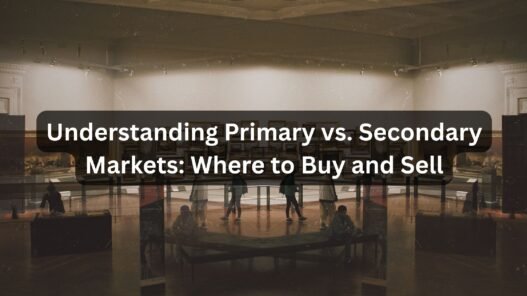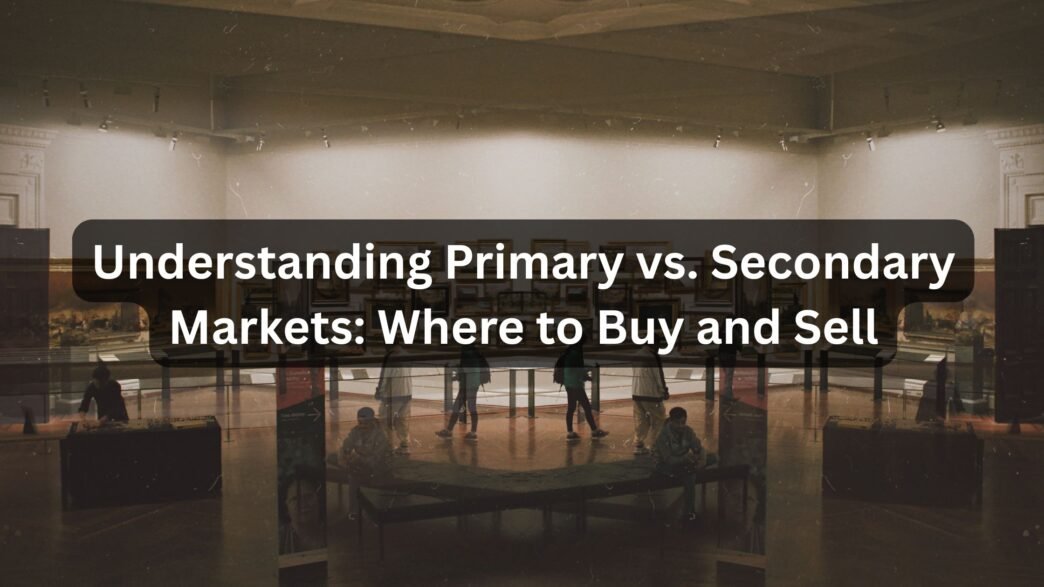Understanding Primary vs. Secondary Markets: Where to Buy and Sell
The world of financial investment is divided into two fundamental marketplaces: the Primary Market and the Secondary Market. While they work together to form the complete ecosystem of capital formation and trading, they serve entirely different purposes for both the issuers of securities and the investors who buy them.
Understanding where a security is being bought or sold is crucial for any investor, as it dictates the transaction process, the price of the security, and even who gets the money from the sale.
1. The Primary Market: The Birthplace of Securities
Think of the Primary Market as the “factory floor” where new financial assets are first created and sold. This is where a company, government, or other entity raises fresh capital directly from investors.
What is it?
The Primary Market is where an issuer sells a new security for the first time to raise money for its operations, expansion, or debt repayment.
- Seller: The company or government that issues the security (the issuer).
- Buyer: The investor (individual or institutional) who buys the new security.
- The Flow of Money: The proceeds from the sale go directly to the issuer.
- Price: The initial price of the security is typically fixed or determined through a pre-issue bidding process.
Key Examples of Primary Market Transactions:
| Transaction Type | Description |
| Initial Public Offering (IPO) | When a private company first sells its stock to the public, becoming publicly traded. |
| Seasoned/Follow-on Offering | When a company that is already public issues new, additional shares or bonds. |
| Private Placement | When new securities are sold directly to a select group of large institutional investors (like hedge funds or banks) instead of the general public. |
| Government Bond Auctions | When a government sells new bonds (like U.S. Treasuries) for the first time to raise debt capital. |
Export to Sheets
For individual investors, access to the primary market, especially for IPOs, is often complex and sometimes limited, with large institutional investors typically getting the largest allocations.
2. The Secondary Market: The Trading Floor
If the Primary Market is the factory floor, the Secondary Market is the “bazaar”—a continuous marketplace where previously issued securities are traded among investors. This is what most people think of when they talk about “the stock market.”
What is it?
The Secondary Market facilitates the buying and selling of securities that are already owned by investors.
- Seller: An existing investor who owns the security.
- Buyer: Another investor who wishes to purchase the security.
- The Flow of Money: The proceeds from the sale go to the selling investor, not the original issuer.
- Price: Prices are constantly fluctuating based on the real-time dynamics of supply and demand (market forces).
Key Examples of Secondary Market Transactions:
| Market Example | Description |
| Stock Exchanges | Major exchanges like the NYSE and NASDAQ are the most famous examples, where millions of shares are traded daily between investors. |
| Over-The-Counter (OTC) Markets | A decentralized network where securities (especially bonds) are traded directly between two parties without a central exchange. |
| Bond Markets | Where previously issued corporate and government bonds are bought and sold after their initial issuance. |
Export to Sheets
The Secondary Market is the most important market for the everyday investor, providing the essential services of liquidity and price discovery.
3. The Core Differences at a Glance
The two markets are distinct yet completely interdependent. The Primary Market cannot function without the promise of a liquid Secondary Market, and the Secondary Market wouldn’t have any securities to trade without the Primary Market.
| Feature | Primary Market (The “New Issue” Market) | Secondary Market (The “After Issue” Market) |
| Nature of Transaction | Sale of new securities. | Sale of existing securities. |
| Seller | The original Issuer (Company/Government). | The existing Investor/Shareholder. |
| Recipient of Proceeds | The Issuer (raises capital). | The Selling Investor (realizes gain/loss). |
| Price Determination | Fixed or determined through bidding/underwriting. | Fluctuates based on Supply & Demand. |
| Main Function | Capital Formation for the issuer. | Liquidity and Price Discovery for investors. |
| Intermediaries | Investment Banks (Underwriters). | Brokers, Stock Exchanges. |
Export to Sheets
Why This Distinction Matters to Investors
- Liquidity: The Secondary Market is what guarantees an investor can sell a security they bought. Without it, your shares would be illiquid and difficult to convert back to cash.
- Price Risk: In the Primary Market (e.g., an IPO), the fixed price is based on the issuer’s valuation. In the Secondary Market, the price is based on current market sentiment, economic news, and the security’s actual performance, which can be more volatile.
- Access: Most individual retail investors spend almost all of their time trading on the Secondary Market through brokerage accounts. Direct access to primary market offerings is often more difficult and restricted.
By understanding the roles of both the Primary and Secondary Markets, you can better grasp how capital is raised and how assets are valued, making you a more informed and strategic investor.


















